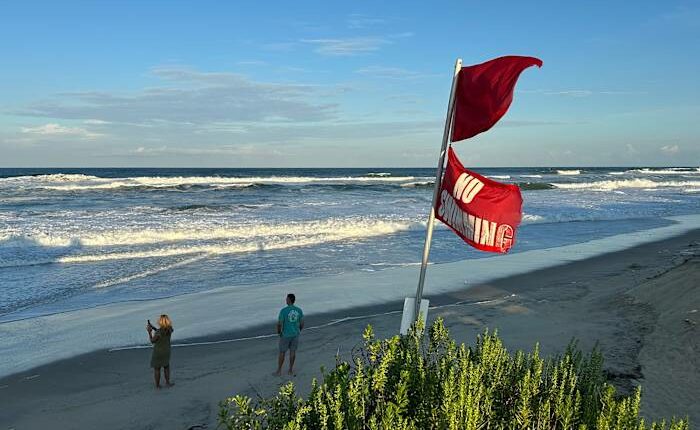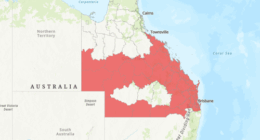Share this @internewscast.com

RODANTHE, N.C. – As Hurricane Erin crept closer on Wednesday, those attempting to enjoy the end of summer from Florida to New England faced rip current warnings, beach closures, and dangerous waves.
Although forecasters are certain that the powerful storm’s center will remain well offshore, its outer bands are set to bring strong winds, huge swells, and perilous rip currents through Friday. However, the East Coast could start experiencing the largest swells as early as Wednesday.
On Wednesday and Thursday, New York City shut down its beaches for swimming, and NY Governor Kathy Hochul mandated that three Long Island state beaches bar swimming until Thursday. Additionally, several beaches in New Jersey will be temporarily closed, and some Delaware towns have restricted ocean access.
Massachusetts’ Nantucket Island faces the potential of waves exceeding 10 feet (3 meters) later this week. However, the most significant risk is on North Carolina’s Outer Banks barrier islands, where evacuation orders have been issued.
Erin has evolved into a particularly vast and deceptively threatening storm, with tropical storm winds extending 230 miles (370 kilometers) from its center. As it travels across the Atlantic and turns north, it is forecasted to expand further.
On Tuesday, it struck the Turks and Caicos Islands, leading to suspended government services and orders for residents to stay home, along with affecting parts of the Bahamas ahead of its predicted movement towards Bermuda.
Tropical storm watches were issued for Virginia and North Carolina as well as Bermuda.
Erin lost some strength from previous days and was a Category 2 hurricane with maximum sustained winds of 100 mph (161 kph), the National Hurricane Center in Miami said. It was about 540 miles (870 kilometers) south-southeast of North Carolina’s Cape Hatteras.
On the Outer Banks, Erin’s storm surge could swamp roads with waves of 15 feet (4.6 meters). Mandatory evacuations were ordered on Hatteras and Ocracoke Islands. More than 1,800 people had left Ocracoke by ferry since Monday.
North Carolina Gov. Josh Stein warned coastal residents to be prepared to evacuate and declared a state of emergency Tuesday. Bulldozers shored up the dunes, and trucks from the local power company on Ocracoke were on hand to respond to downed wires.
Some side roads already saw some flooding on Hatteras, and the owners of a pier removed a few planks, hoping the storm surge would pass through without tearing it up.
Most residents decided to stay even though memories are still fresh of Hurricane Dorian in 2019, when 7 feet (2.1 meters) of water swamped Ocracoke, county commissioner Randal Mathews said.
Tom Newsom, who runs fishing charters on Hatteras, said has lived there almost 40 years and never evacuated. He was not going to this time either.
Comparing this hurricane to others he has seen, he called this one a “nor’easter on steroids.”
The Outer Banks’ thin stretch of low-lying barrier islands jutting into the Atlantic are increasingly vulnerable to storm surges. There are concerns that parts of the main highway could be washed out, leaving some routes impassible for days. And dozens of beach homes already worn down from chronic beach erosion and the loss of protective dunes could be at risk, said David Hallac, superintendent of the Cape Hatteras National Seashore.
Farther south, no evacuations were ordered but some beach access points were closed with water levels up to 3 feet (1 meter) over normal high tides expected for several days.
Climate scientists say Atlantic hurricanes are now much more likely to rapidly intensify into powerful and catastrophic storms fueled by warmer oceans. Two years ago Hurricane Lee grew with surprising speed while barreling offshore through the Atlantic, unleashing violent storms and rip currents.
___
Seewer reported from Toledo, Ohio. Associated Press journalists Dave Collins in Hartford, Connecticut; Jeffrey Collins in Columbia, South Carolina; Gary Robertson in Raleigh, North Carolina; Ben Finley in Norfolk, Virginia; Hallie Golden in Seattle; Leah Willingham in Boston; Safiyah Riddle in Montgomery, Alabama; and Julie Walker in New York contributed.
Copyright 2025 The Associated Press. All rights reserved. This material may not be published, broadcast, rewritten or redistributed without permission.
















